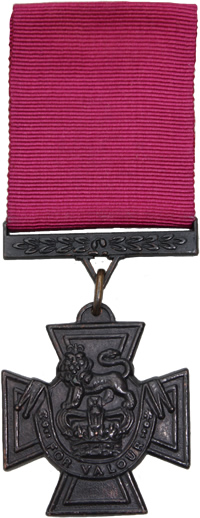Victoria Cross (V.C.)
(Level 1 Gallantry Award)

This is the highest award for gallantry. It is awarded for an act of outstanding courage or devotion to duty in the presence of the enemy. All ranks were, and still are, eligible when serving with the British and Commonwealth armed forces.
The Royal Warrant for the award of the Victoria Cross has essentially remained the same since the inception of the medal to the present day. It was, and still is, awarded “for most conspicuous bravery, or some daring or pre-eminent act of valour or self-sacrifice, or extreme devotion to duty in the presence of the enemy.” The Victoria Cross can also be awarded to civilians if they were under military command at the time of the act of bravery.
Origin of the Victoria CrossThe Victoria Cross was instituted on 29th January 1856.
At the time of the Crimean War (1853-1856) the British military - which consisted of the Royal Navy and the Army - did not have a gallantry medal open to all ranks. The idea was put forward to the British House of Commons by a Member of Parliament and ex-Royal Navy man, Captain T Scobell. It was also suggested as an idea by the then Secretary of State, the Duke of Newcastle.
His successor, Lord Panmure, carried on with the correspondence about the new gallantry medal already established with Prince Albert. Queen Victoria was very interested in the medal, especially as it was to be named after her. She preferred the name of “Victoria Cross” to the suggested title of “The Military Order of Victoria”. Victoria involved herself by making suggestions about the design and the metal it could be made of. She was the person who suggested that the design should bear the words “For Valour” instead of the suggested words “For the Brave”. The word “valour” extended a special significance to an act of extra special bravery and courage, which might be considered to be more than an act of “bravery”.
Queen Victoria did not like the original copper cross which was submitted for approval. A suggestion was made to create the medal from the cascabels (the knob and the neck of a breech-loading cannon) of two Russian cannons captured in the Crimea. As has been examined in a recent study(2), the two 18 pounder cannons which were provided for creating the Victoria Cross medals were Chinese in origin, not Russian. One theory is that the guns were captured by the Russians from the Chinese and used against the British Army in the battle at Sevastopol. It has also been suggested that the metal used for the Victoria Crosses cast during the First World War did not come from these two original cannons, but from other Chinese guns captured in the Boxer Rebellion (1898-1901).
The Royal Warrant for the Victoria Cross was issued on 29th January 1856. The first investiture ceremony was held a few months later in Hyde Park on 26th June 1856. 62 awards were issued for acts of valour during the Crimean War (1853-1856).
There is approximately 10kg of remaining metal from the two cascabels of the original cannons reputed to have come from Sevastopol. This is stored in a secure vault and can only be taken out of the vault under an armed guard. The same jewellers, Hancocks of London, has been responsible for casting the Victoria Cross medal from the first one to the present day.
Source: The Great War 1914-1918